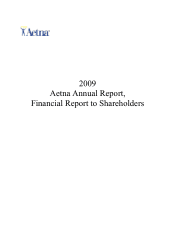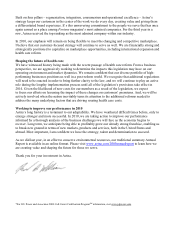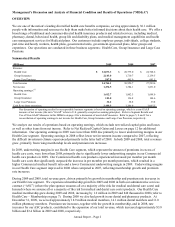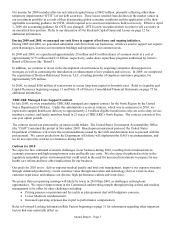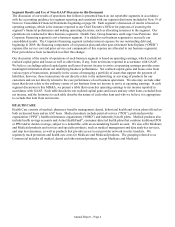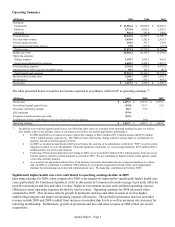Aetna 2009 Annual Report Download - page 9
Download and view the complete annual report
Please find page 9 of the 2009 Aetna annual report below. You can navigate through the pages in the report by either clicking on the pages listed below, or by using the keyword search tool below to find specific information within the annual report.Annual Report – Page 3
Net income for 2008 includes after-tax net realized capital losses of $482 million, primarily reflecting other-than-
temporary impairments (“OTTI”) of our debt securities. These losses resulted from declines in the market values in
our investment portfolio as a result of then deteriorating global economic conditions and the application of the then-
applicable accounting guidance for OTTI, which required us to assert our intention to hold to recovery. Effective April
1, 2009, the accounting guidance for OTTI was changed. OTTI is now recognized when we plan to sell a security in
an unrealized loss position. Refer to our discussion of Net Realized Capital Gains and Losses on page 12 for
additional information.
During 2009 and 2008, we managed our cash flows in support of both new and ongoing initiatives.
During 2009 and 2008, we generated substantial cash flows from our businesses, which we used to support our organic
growth strategies, increase our investment holdings and repurchase our common stock.
In 2009 and 2008, we repurchased approximately 29 million and 43 million shares of common stock at a cost of
approximately $773 million and $1.8 billion, respectively, under share repurchase programs authorized by Aetna’ s
Board of Directors (the “Board”).
In addition, we continue to invest in the development of our business by acquiring companies that support our
strategies as well as continuing the introduction or enhancement of new products and services. In 2009, we completed
the acquisition of Horizon Behavioral Services, LLC, a leading provider of employee assistance programs, for
approximately $70 million.
In 2008, we issued $500 million of senior notes to secure long-term capital at favorable rates. Refer to Liquidity and
Capital Resources beginning on page 13 and Note 14 of Notes to Consolidated Financial Statements on page 75 for
additional information.
TRICARE Managed Care Support Contract
In July 2009, we were awarded the TRICARE managed care support contract for the North Region by the United
States Department of Defense. Under this administrative services contract, which was to commence in 2010, we
expected to support health care delivery to approximately 2.8 million eligible beneficiaries who are active duty service
members, retirees, and family members based in 21 states of TRICARE’ s North Region. The contract consists of five
one-year option periods.
The contract award was protested by an unsuccessful bidder. The United States Government Accountability Office
(the “GAO”) sustained the protest in November 2009. Based upon procurement protocol, the United States
Department of Defense will review the recommendations issued by the GAO and determine how to proceed with the
procurement. We cannot predict how the Department of Defense will implement the GAO’ s recommendations, and
we do not expect the contract to commence during 2010.
Outlook for 2010
We expect to face continued economic challenges in our business during 2010, resulting from continued macro-
economic pressures and high unemployment rates and health care costs. We also expect heightened activity in the
regulatory and public policy environments that could result in the need for increased investments to prepare for any
health care reform and have other implications for our business.
Our goals for 2010 are to: deliver superior medical quality and total cost management; improve our expense structure
through enhanced productivity; create customer value through innovation and technology; deliver a best-in-class
customer experience; and enhance our diverse, high-performance culture and work force.
We project that our operating earnings will likely be lower in 2010 than 2009, as challenges outweigh our
opportunities. We expect improvement in the Commercial underwriting margin through pricing actions and medical
management to be offset by other challenges including:
Pricing pressure on premium and fee yields as plan sponsors deal with budgetary concerns.
Lower Medicare reimbursement.
Increased operating expenses due in part to performance compensation.
Refer to Forward-Looking Information/Risk Factors beginning on page 31 for information regarding other important
factors that may materially affect us.

